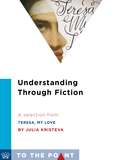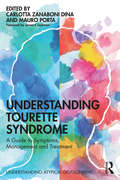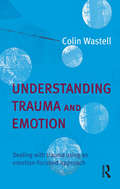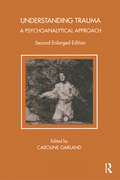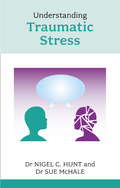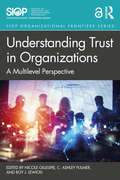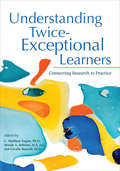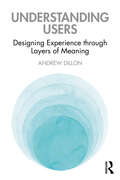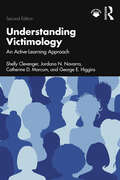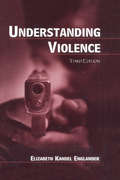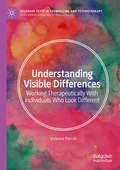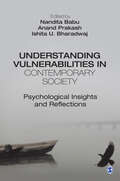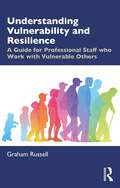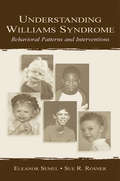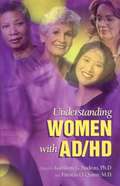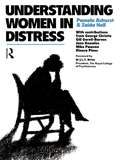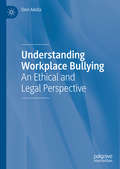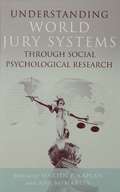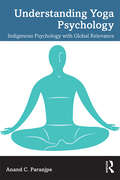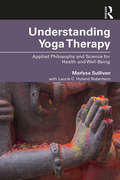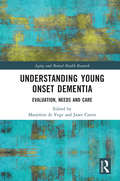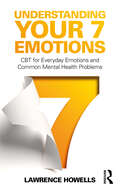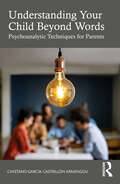- Table View
- List View
Understanding Through Fiction: A Selection from Teresa, My Love: An Imagined Life of the Saint of Avila (To the Point)
by Julia KristevaBorn in 1515, Teresa of Avila survived the Spanish Inquisition and was a key reformer of the Carmelite Order. Her experience of ecstasy, which she intimately described in her writings, released her from her body and led to a complete realization of her consciousness, a state Julia Kristeva explores as it was expressed in Teresa's writing. Incorporating notes from her own psychoanalytic practice, as well as literary and philosophical references, Kristeva builds a fascinating dual diagnosis of contemporary society and the individual psyche while sharing unprecedented insights into her own character. Through her dazzlingly varied formats Kristeva tests the borderlines of atheism and the need for faith, feminism and the need for a benign patriarchy.
Understanding Tourette Syndrome: A guide to symptoms, management and treatment (Understanding Atypical Development)
by Carlotta Zanaboni Dina Mauro PortaUnderstanding Tourette Syndrome provides accessible, concise, evidence-based guidelines on this neurodevelopmental disorder, offering parents and professionals a deeper scientific understanding of the condition and its consequences. Zanaboni Dina and Porta explore signs, symptoms and treatment of the disease, with the aim of demonstrating to all those involved in the life of a TS child solutions to manage a range of situations from diagnosis to day-to-day life. Therapies and social intervention, including Habit Reversal Training and Deep Brain Stimulation, are described, allowing caregivers to evaluate the best course of treatment. With a focus on improving quality of life by offering practical recommendations for managing the condition at school and in the family, it places additional emphasis on sibling relationships and the importance of childhood friendship. The authors’ expert subject knowledge and extensive experience of working with children and families, makes the topic accessible for any reader, and case studies demonstrate how to apply scientific understanding of the condition to a real-life situation. This unique guide is essential reading for parents and carers, as well as practitioners in Clinical and Educational Psychology, Counselling, Mental Health, Nursing, Child Welfare, Public Healthcare and those in Education. It will also be of interest to postgraduates studying courses in Psychology, Neurology and Psychiatry.
Understanding Trauma and Emotion: Dealing with trauma using an emotion-focused approach
by Colin WastellI recommend this scholarly and readable book to all concerned with the field of stress and trauma. Students and clinicians will find it equally beneficial.Mardi J. Horowitz, M.D. Professor of Psychiatry, University of California, San Francisco and author of Stress Response Syndromes and Treatment of Stress Response SyndromesThis is a remarkably good book. One seldom sees such exquisite balance of scholarship, practical relevance and compassion for both client and counsellor. I recommend it most highly.Michael J. Mahoney, author of Constructive Psychotherapy and Human Change ProcessesUnderstanding Trauma and Emotion is an essential reference for all clinicians working in the area of trauma . . . and provides a comprehensive and very accessible account of the emotion-focused model of psychological trauma.Michelle A. Webster, PhD, Institute for Emotionally Focused Therapy, SydneyHow do we help the traumatised?How can we better understand someone who has faced death, violence or imprisonment?Traumatic experiences can leave an indelible impression on those involved, one which the person may suppress or re-live with destructive and troubling consequences. For many traumatised individuals the essence of their trauma is deeply emotional: terror, anger, anxiety.Colin Wastell interprets the modern understanding of the traumatic process and presents his own model based on extensive research. He examines the role of emotion in human function and in particular its role in the experience of trauma and effective trauma treatment.Wastell's approach is grounded in practical treatment and the way emotion-focused therapy can be used to benefit the therapist and client. Using extensive case studies and making clear links between theory and practice, Wastell presents an innovative practice manual for the counsellor and psychologist interested both in trauma treatment and human emotion. These principles for understanding trauma will also assist health professionals, including nurses, doctors, ambulance officers, social workers, religious leaders, emergency services workers and police officers, to help their clients.This book is also supported by a website, containing a full report of the author's research at: www.allenandunwin.com/trauma.asp
Understanding Trauma: A Psychoanalytical Approach (Tavistock Clinic Series)
by Caroline GarlandRevised edition with additional chapter. This book, from the Tavistock Clinic Series, is about what follows the breakdown in functioning, either short or longer-term, provoked by a traumatic event. The authors offer a psychoanalytical understanding of the meaning of the trauma for an individual, illuminating theory with detailed clinical illustration and case histories. A range of therapeutic procedures is described.Major disasters draw attention forcibly to their effects on the survivors. Less often recognised are the long-term after-effects of the huge number and variety of more private events, either accidental or deliberately inflicted, on an individual's subsequent emotional and working life. This book is about what follows the breakdown in functioning, either short or longer-term, provoked by a traumatic event.What is distinctive about this book is that its authors offer a psychoanalytical understanding of the meaning of the trauma for an individual, illuminating theory with detailed clinical illustration and case histories. They show the process of treatment as their patients restore meaning to their lives, moving towards a new integration in which the event becomes a part of the whole, no longer dominating either waking or sleeping life. A range of therapeutic procedures is described, including a short series of individual consultations, groups and full analysis. A challenging and innovative work, rooted in psychoanalysis, this collection thoughtfully describes in detail the work for the Unit for the Study of Trauma and its Aftermath in the Adult Department of the Tavistock Clinic.
Understanding Traumatic Stress
by Nigel HuntTraumatic events are common, and range from road traffic accidents, through rape and sexual abuse, to disaster and war. While many people deal effectively with these experiences, a minority have severe problems, which are often manifested as post-traumatic stress disorder (PTSD). The book is aimed at those with PTSD and those who are caring for someone with the disorder. It includes a strong focus on wounded military personnel. Topics include: understanding the symptoms including memory problems, avoidance and denial, emotional numbing, and hyperarousal, related disorders such as depression and substance abuse; traumatic memories and the underlying biology - how brain mechanisms are affected in the response to traumatic events. Treatments such as cognitive behavioural therapy and EMDR. Narrative approaches, whereby people develop their own stories about their traumatic experiences to help them put them into meaningful contexts; Drug techniques including anxiolytics and antidepressants, and the problems of prescribing drugs for such a complex disorder; Problems faced by carers; Vicarious or secondary trauma; Growing through experience - trauma from an alternative perspective, that of resilience and growth; Professional help - your GP, clinical psychologists and psychiatrists.
Understanding Treatment of Mild Traumatic Brain Injury in the Military Health System
by Carrie M. Farmer Heather Krull Thomas W. Concannon Kimberly A. Hepner Teague Ruder Andrew M. Parker Benjamin Batorsky Francesca Pillemer Liisa Hiatt Maulik P. Purohit Molly SimmonsA RAND study, the first to examine care received by a census of active-duty service members diagnosed with mild traumatic brain injury in the Military Health System, assessed the number and characteristics of these patients (including deployment history and history of traumatic brain injury), their care settings, the treatments they received, co-occurring conditions, the duration of treatment, and the risk factors for requiring long-term care.
Understanding Trust in Organizations: A Multilevel Perspective (SIOP Organizational Frontiers Series)
by Nicole Gillespie, C. Ashley Fulmer, and Roy J. LewickiUnderstanding Trust in Organizations: A Multilevel Perspective examines trust within organizations from a multilevel perspective, bringing together internationally renowned trust scholars to advance our understanding of how trust is affected by both macro and micro forces, such as those operating at the societal, institutional, network, organizational, team, and individual levels. Understanding Trust in Organizations synthesizes and promotes new scholarly work examining the emergence and embeddedness of multilevel trust within organizations. It provides a much-needed integration and novel conceptual advances regarding the dynamic interplay between micro and macro levels that influence trust. This volume brings new insights into how trust in groups, networks, and organizations forms, and why employees can differ in their trust in leaders and teams. Providing rich and nuanced insights into how to develop, maintain, and restore trust in the workplace, Understanding Trust in Organizations is a critical resource for scholars, graduate students, and researchers of industrial and organizational psychology, as well as practitioners in fields such as human resource management and strategic management.
Understanding Twice-Exceptional Learners: Connecting Research to Practice
by Wendy Behrens Cecelia Boswell C. FugateUnderstanding Twice-Exceptional Learners offers an in-depth look at the needs and lived experiences of students who are twice-exceptional. This book:Includes detailed examinations of co-occurring disabilities commonly found in twice-exceptional populations.Features studies of ADHD, dyslexia, dyscalculia, autism spectrum disorders (ASD), anxiety, OCD, and more.Bridges the divide between research about and practical strategies for teaching gifted students with learning challenges.Is Ideal for university teacher preparation courses and graduate programs.Provides strength-based strategies that focus on students' unique gifts and talents.Each chapter includes a comprehensive literature review, suggested interventions, resources for further exploration, and vignettes that highlight experiences of twice-exceptional students and the behaviors and needs that practitioners might commonly see in the classroom.
Understanding Users: Designing Experience through Layers of Meaning
by Andrew DillonGrounded in the user-centered design movement, this book offers a broad consideration of how our civilization has evolved its technical infrastructure for human purpose to help us make sense of our contemporary information infrastructure and online existence. The author incorporates historical, cultural, and aesthetic approaches to situating information and its underlying technologies across time in the collective, lived experiences of humanity. In today’s digital environment, user experience is vital to the success of any product or service. Yet as the user population expands to include us all, designing for people who vary in skills, abilities, preferences, and backgrounds is challenging. This book provides an integrated understanding of users, and the methods that have evolved to identify usability challenges, that can facilitate cohesive and earlier solutions. The book treats information creation and use as a core human behavior based on acts of representation and recording that humans have always practiced. It suggests that the traditional ways of studying information use, with their origins in the distinct layers of social science theories and models is limiting our understanding of what it means to be an information user and hampers our efforts at being truly user-centric in design. Instead, the book offers a way of integrating the knowledge base to support a richer view of use and users in design education and evaluation. Understanding Users is aimed at those studying or practicing user-centered design and anyone interested in learning how people might be better integrated in the design of new technologies to augment human capabilities and experiences.
Understanding Victimology: An Active-Learning Approach
by George E. Higgins Catherine D. Marcum Shelly Clevenger Jordana N. NavarroUnderstanding Victimology: An Active Learning Approach is the only textbook with extensive discussion of both online and offline victimization reinforced by group and individual learning activities. Our textbook offers instructors a variety of active learning exercises – in the book itself and in the authors’ ancillaries – that engage students in the material and shed light on the experiences of marginalized social groups. Through these activities, students become engaged with the material at a higher level of learning. They learn how victimization happens and the challenges people who experience crime face in acquiring assistance from the criminal-legal system at a more intimate level instead of simply reading about it. Students also build their abilities to work with others in a collaborative learning environment, encouraging professional socialization for the future. The chapters in this second edition address gaps in information typically presented in victimology that ignore prevention or intervention, even though these topics are currently at the forefront of the national conversation going on about sexual violence in higher education. New to this edition are added coverage of immigrants and minorities and new chapters on the media and victimization and on victimization across the gender spectrum, as well as an online instructor resource covering UK case studies, legal framework, and social context that broadens the book’s global appeal. Suitable for undergraduate courses in victimology, this book also serves the needs of sociology and women’s studies courses and can be taught university-wide as part of diversity and inclusion initiatives.
Understanding Violence
by Elizabeth Kande EnglanderWhat impels human beings to harm others -- family members or strangers? And how can these impulses and actions be prevented or controlled? Heightened public awareness of, and concern about, what is widely perceived as a recent explosion of violence -- on a spectrum from domestic abuse to street crime -- has motivated behavioral and social scientists to cast new light on old questions. Many hypotheses have been offered. This volume sorts, structures, and evaluates them.The author draws on contemporary research and theory in varied fields--sociology, clinical psychology, psychiatry, social work, neuropsychology, behavioral genetics, child development, and education--to present a uniquely balanced, integrated, and readable summary of what we currently know about the causes and effects of violence. Throughout, she emphasizes the necessity of distinguishing among different types of violent behavior and of realizing that nature and nurture interact in human development. Controversial issues such as physical punishment and violent television programming receive special attention making this volume an important resource for all those concerned with violent offenders and their victims -- and for their students and trainees.In this third edition of Understanding Violence, author Elizabeth Kandel Englander draws on contemporary research and theory in varied fields to present a uniquely balanced, integrated, and readable summary of what we currently know about the causes and effects of violence, particularly its effect on children. The goal of this textbook is to give a critical review of the most relevant and important areas of research on street and family violence, examining why it is that people become violent. Between 1994 and 2004 the United States benefited from a dramatic decline in rates of violent crime. However, as the economy has weakened in recent years and tougher times have returned, the crime rate has shown signs of a modest
Understanding Visible Differences: Working Therapeutically With Individuals Who Look Different (Palgrave Texts in Counselling and Psychotherapy)
by Vivienne PurcellThis book provides an evidence-based guide to working with visible difference in therapeutic practice. It explores how appearance problems intersect with other concerns causing mental health issues and provides clear guidance on treatment plans and related topics. Visible difference is a bigger cause of mental distress than is often realised. One in five people have an appearance that is considered ‘different’ to the normal population. The category of ‘visible difference’, previously described as ‘disfigurement’ or simply ‘disability’ captures a range of conditions with varying aetiology, severity, and extent. Differences in appearance can be the result of a birth anomaly, or be caused later in life through illness, physical trauma, or behaviour. Whatever the cause, visible difference can have a negative effect on how individuals are perceived and view themselves. This timely work arrives at a moment of rising professional interest, due to the growth of social media use and the focus this puts on appearance (“the amplification of appearance bias”), and also influenced by the implications new research. The author draws on these findings together with her own research and practice to examine best practice and key issues in addressing visible difference. Particular consideration is given to establishing a good working therapeutic relationship. Whether a trainee, a recently qualified therapist, or an experienced professional wanting to broaden their understanding, this is the ideal text for anyone wanting to better understand this growing area of therapeutic practice.
Understanding Vulnerabilities in Contemporary Society: Psychological Insights and Reflections
by Anand Prakash Nandita Babu Ishita U. BharadwajUnderstanding Vulnerabilities in Contemporary Society: Psychological Insights and Reflections explores the constructs of ‘vulnerability’, with an aim to move beyond the linguistic and normative appropriation of the word. It does this by uncovering diverse life experiences of varied individuals and communities who have largely remained unseen and unheard. With dynamically transitioning sociocultural circumstances, the boundaries demarcating the included versus the excluded, the accepted versus the unacceptable other, the endeared versus the disparaged continue to multiply. As we struggle with these numerous identities and categories, we are forced to encounter compounded vulnerabilities. The book explores the various ways in which an individual encounters and even embraces vulnerability in order to ensure survival. To help readers arrive at a broad understanding of the many underlying concerns, the book explores diverse issues such as gender, sexuality, adolescence, child abuse, exploitation, forced migration and homelessness. Based on rigorous empirical work, using traditional and alternative approaches to inquiry, the book provides critical insights for psychosocial and clinical interventions and will especially be of interest to psychologists, therapists and counsellors.
Understanding Vulnerability and Resilience: A Guide for Professional Staff who Work with Vulnerable Others
by Graham RussellThis book offers an accessible and evidence-based approach for professional staff to improve their interactions with vulnerable people. Drawing upon contemporary research from a broad array of disciplines, including psychology, sociology, economics, biology and the neurosciences, it demonstrates how vulnerability and resilience are not fixed personality traits, as is commonly assumed, but rather fluid and dynamic states that result from inhibitory and developmental factors that reside within individuals and their external environments. Each chapter focuses on factors that create vulnerability and those that promote resilience with reference to important subjects, such as child development, epigenetics, trauma, shame, addiction, poverty, emotional intelligence, personality, empathy, compassion and behaviour-change. Attention is given to the role of positive, early life experiences in creating an internal working model of the world that is based on trust, intimacy and hope and how the root causes of vulnerability often lie in the cyclical relationship that exists between child maltreatment, trauma and socially deprived environments that cumulatively act to keep people locked in states of inter-generational poverty. The author explores pressing and important workplace issues, such as occupational stress and burnout, and highlights the urgent need for compassionate systems of management that are functionally equipped to address human error, stress and trauma in complex professional arenas where staff are continually exposed to other peoples’ suffering. The book also demonstrates how strategies and processes which coerce individuals and groups into changing their behaviour are generally counterproductive and it explains how resilient change is invariably supported by strategies that enhance trust, cooperation, personal control and self-efficacy. This book will benefit professional staff, including health, emergency and social services, humanitarian workers, counsellors and therapists, as well as students who want to learn more about the conceptual frameworks that explain vulnerability and resilience.
Understanding Wellbeing in Higher Education of the Global South: Contextually Sensitive and Culturally Responsive Perspectives (Wellbeing and Self-care in Higher Education)
by Abdellatif Sellami Youmen Chaaban Igor MichaleczekThis edited book gives voice to previously unheard narratives on wellbeing in higher education and provides novel implications for higher education policy and practice.Offering contextually sensitive and culturally responsive perspectives, the book problematizes wellbeing in higher education as it is currently theorized in the Global North, bringing to the fore perspectives and multi-disciplinary insights from the Global South region. Chapters present an alternative conceptualization of wellbeing in higher education based on stories, perceptions, and experiences of university students, faculty, and leaders from the Global South region, challenging a reductionist view of wellbeing and embracing its complexity, multi-dimensionality and context-sensitivity. The authors present an alternative non-Western approach to thinking, researching, and doing wellbeing in higher education, offering clear guidelines to support teachers, educational researchers, and leaders in fostering a more holistic teaching and learning experience.This volume will stimulate policy development and enactment, as well as university-wide interventions and practices that can make a difference in the lives of students in higher education.
Understanding Williams Syndrome: Behavioral Patterns and Interventions
by Eleanor Semel Sue R. RosnerComprehensive and readable, Understanding Williams Syndrome: Behavioral Patterns and Interventions is an essential guide for all those professionally, scientifically, or personally involved with this so frequently misunderstood and underserved population--psychologists, psychiatrists, social workers, and other mental health professionals; special educators and vocational counselors; speech-language, physical, and occupational therapists; audiologists; physicians; and parents. In the last 20 years, Williams syndrome has captured the interest of large numbers of scientists and attracted considerable media attention in spite of its rarity (estimated at no more than one in 30,000 births). Those diagnosed display a unique pattern of behavioral, cognitive, and physical limitations and strengths with fascinating neurogenetic implications--a pattern that poses enormous challenges to their parents and caregivers. The authors, a specialist in learning disabilities and a developmental psychologist, review basic information about Williams syndrome, its medical conditions, paradoxical profile, and neurobiological mechanisms; and discuss distinctive features of the language and perceptual and motor performance of children and adults with the syndrome. Other features include:* Strategies for working with patients.* An examination of the difference between Williams syndrome and other developmental disorders.* Problem-specific alternatives for treatment.* Analysis of new directions in research, clinical intervention, education, and systems for care delivery. Throughout, they stress variations among individuals and subgroups in ability level, skills, talents, and problem severity; and emphasize the necessity of recognizing these components in planning treatment on an individual basis.
Understanding Women With AD/HD
by Kathleen G. Nadeau Patricia O. QuinnUnderstanding Women with AD/HD is designed to be a practical and readable guide for women at any age, with special chapters focusing on different stages of life.
Understanding Women in Distress
by Dr Pamela Ashurst Dr Zaida HallWomen are usually more in touch with their emotions than men and more readily seek help from professional sources when they encounter stress. The response they meet from doctors and other helping professionals at this point can be vital in determining the best outcome for them. Ashurst and Hall have written this book as a contribution towards a better understanding of the psychological aspects of women's health problems.
Understanding Workplace Bullying: An Ethical and Legal Perspective
by Devi AkellaThis book examines the ethical and legal aspects of workplace bullying from a global perspective. Through an in-depth exploration of this psychologically destructive managerial technique, it identifies workplace bullying as a highly potent tool in the short term to increase employee performance. By deconstructing and exposing the dark side of workplace bullying, not as a psychological harmful component, not as a health-related stress issue, but instead as a management tool to exercise totalizing control over the employee, this book explores the ethical modalities which managers tend to cross on a daily basis to get things accomplished within an organization. This book offers researchers a thorough examination of management responsibilities and the power of enforcement strategies used by managers.
Understanding World Jury Systems Through Social Psychological Research
by Martin F. Kaplan Ana M. MartínThis volume examines diverse jury systems in nations around the world. These systems are marked by unique features having critical implications for jury selection, composition, functioning, processes, and ultimately, trial outcomes. These unique features are examined by applying relevant social psychological research, models and concepts to the central issues and characteristics of jury systems in those nations using a wide variety of jury procedures. Traditionally, research that has been conducted on juries has almost exclusively targeted the North-American jury. Psychologically-based research on European, Asian and Australian juries has been almost non-existent in the past decade or more. Yet, the incidence of jury trials outside of North America has been steadily increasing as more nations (e.g., Japan, Spain, Russia, and Poland) adopt, revise, or expand their use of juries in their legal system. Accordingly, research has been appearing in the scientific literature on new developments in world juries (particularly in Spain, Japan, and Australia). This volume fulfils the dual purpose of understanding the diverse practices in world juries in light of existing social psychological knowledge and applied research on juries in each nation, and outlining new research in the context of the issues raised by jury practices beyond those of North America.
Understanding Yoga Psychology: Indigenous Psychology with Global Relevance
by Anand C. ParanjpeThis book is an introduction to Patañjali’s Yoga Sūtras and its core concepts about the self, suffering and consciousness. It highlights its relevance to contemporary theories and applications in the fields of psychology and health. The book adopts sociology of knowledge as a broad framework as it delves into the core concepts of yoga psychology in the Yoga Sūtras in the context of worldviews and frameworks present in the Upanisads and the Sāṁkhya system. It provides an interpretation of Kriya Yoga and its practice in pursuit of spiritual upliftment, and concept of Samādhi or the transformation of consciousness using the language and idiom of contemporary psychology. It draws parallels between yoga psychology and the ideas of Husserl, Jung and Piaget while reconciling the seemingly disparate cultural, religious, spiritual, and intellectual traditions of eastern spirituality and schools of modern psychology. The book also discusses yoga psychology in relation to psychoanalysis, radical behaviorism as well as mainstream, cognitive, humanistic, transpersonal and indigenous psychologies and provides a guide to both the theories of yoga psychology and its applications. This book will be of interest to students, teachers, researchers and practitioners of psychology, psychiatry, philosophy and yoga psychology as well as to psychologists, psychiatrists, counselors, mental health professionals, clinical psychologists, and yoga enthusiasts.
Understanding Yoga Therapy: Applied Philosophy and Science for Health and Well-Being
by Marlysa B. Sullivan Laurie C. Hyland RobertsonUnderstanding Yoga Therapy offers a comprehensive and accessible perspective on yoga therapy as a complementary, integrative route to promoting whole-person well-being. Readers will come away from the book understanding how the philosophy, texts, and teachings of yoga benefit a wide range of health conditions. The book is split into three helpful sections: Part I discusses foundational texts and their interpretations; Part II outlines the biopsychosocial-spiritual and neurophysiological model of integrative health pertinent to yoga therapy; and Part III focuses on practical applications separate from the more familiar diagnosis-driven models. Experiential activities and case studies throughout the text illuminate how yogic practices can be incorporated for optimal health. Bridging the ancient and modern, philosophical and scientific, Understanding Yoga Therapy offers a clear explanatory framework for yoga therapists, physicians, allied and complementary healthcare providers, and their patients and students.
Understanding Young Onset Dementia: Evaluation, Needs and Care (Aging and Mental Health Research)
by Marjolein De VugtUnderstanding Young Onset Dementia provides a state-of-the-art overview of approaches to care and evaluation for people with young onset dementia. It reviews the challenges in providing care and services, outlines new innovations in treatment and explores the impact of the condition to offer guidance about best practice in care. Written by world-leading researchers and experts in the field, this book gives key evidence for best practice and focuses on lived experience of those with young onset dementia. It has a broad focus looking at aspects of care beyond diagnosis and gives a comprehensive summary of the current qualitative and quantitative research in the field of young onset dementia. This international collaboration fills a much-needed gap in the academic market and is vital to guide learning and deliver future innovations. This book will be of great interest for academics, scholars and post graduate students in the field of mental health and dementia research. It will also appeal to neurologists, psychiatrist, geriatricians and psychologists looking to update their knowledge or already working in the field.
Understanding Your 7 Emotions: CBT for Everyday Emotions and Common Mental Health Problems
by Lawrence HowellsUnderstanding Your 7 Emotions explains how emotions help us to respond to the world around us and are fundamental to our existence. The book provides a detailed understanding of the main human emotions – fear, sadness, anger, disgust, guilt, shame and happiness – showing how to live with them and how to resolve problems with them. Each of the seven chapters also includes an ‘emotional trap’ to highlight what happens when we get stuck responding in unhelpful ways and explains how to get out of the trap. Grounded in emotion science and cognitive behavioural therapy, the book provides a powerful alternative to mental health diagnosis. Examples and exercises are provided throughout to help apply the ideas in everyday life and achieve health and happiness. This easy-to-read guide will help anybody who is interested in emotions or is struggling with common mental health problems to better understand how emotions work and improve their own and others' mental health and emotional wellbeing. It will also be an invaluable resource to those working in the caring professions.
Understanding Your Child Beyond Words: Psychoanalytic Techniques for Parents
by Cayetano García-Castrillón ArmengouUnderstanding Your Child Beyond Words: Psychoanalytic Techniques for Parents will help you unlock a deeper knowledge of your child's feelings, inviting you to explore the deepest questions about parenting and find meaningful answers.In this book, expert psychoanalyst Cayetano García-Castrillón Armengou teaches you how to look beyond your child's spoken and non-verbal behavior to truly listen to them. By adopting the methods explored in the book, you will become open to new ideas on how to talk, act, and guide your child more effectively. This understanding will help your family grow together, avoid common misunderstandings, and create lasting, meaningful relationships. The book uses simple language and offers numerous examples from everyday reality, showing how everyone in the family can get to know each other better.Whether your child is already in therapy, you’re considering it, or you simply want to enhance your parenting approach, this book provides invaluable insights and guidance to help you unlock your family’s full potential.
